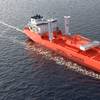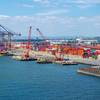Tragedies in the maritime industry are often revered, particularly when a large loss of life occurs, as was the case when RMS Titanic sank on April 14, 1912. The industry is also noted for its ability to learn from mishaps, incorporating changes in design, procedures and operations that are designed to avert future mishasps.
Lessons learned and positive results occurring in the aftermath of Titanic are numerous and still growing, as a team exploring the formation of rusticles on Titanic's hull are drawing some interesting conclusions regarding the natural removal of iron from steel, and the potential compromise in safety and performance this may have, particularly on double-hulled vessels.
The fascination with and examination of Titanic has been thorough, to put it mildly. Explorers have combed the sunken ship for reasons both scientific, historic and commercial ever since its final resting place was located. Forensic experts have pieced together many of the parts of the puzzle that caused the torn and broken ship to lie where she now rests. With that discovery 14 years ago, one feature that stood out in those first images of the ship was that the ship was festooned with rust-like growths, called rusticles, hanging down all over the hull and spreading out across the ocean floor in a slow moving rippling wave of growth. Regular visits to the site of the RMS Titanic reveal an ongoing deterioration coupled to larger masses of rusticles. Learning from the tragedy involves the forensic exercise and now the nature, form, function and consequences of the infestations of rusticles now coating much of the steel hull. Basic questions are: How long does the ship have left as a recognizable structure? What are the rusticles? Where is the iron going? Why involve a microbiologist in the investigation?
As a part of a team that has worked on water wells for three decades, one of the first observations is that the rusticles look very much like the iron bacterial growths often found down water wells. This was particularly true of iron cased water wells suffering from biological plugging. The technologies and experiences were transferred to the RMS Titanic site in the 1990's with the IMAX expedition followed by the 1996 and 1998 expeditions. Of particular concern was the rate at which the deterioration of the ship was occurring and what was the rusticles role in this event. In both 1996 and 1998, rusticles were recovered both directly from the hull and also from steel recovered from the site. Using images from these and other expeditions, it became very evident that the rusticles are growing faster, covering more of the steel, while at the same time, the ship's structures are beginning to collapse in a form of biological implosion. The questions therefore relate to what are the rusticles, why are they there, and where is the iron going?
In 1996, a preliminary survey was made of the bow on the wreck site and the size and mass of the rusticles projected. Subsequent analysis found the iron content ranged from 20 to 36 percent (average, 27 percent) with densities ranging from 1.2 to 1.8 (average, 1.4). All of the rusticles were very porous and retained 25 to 60 percent of the water when subjected to passive drainage. This was due to a sorptive capacity of 25 to 95 (average, 40) sq. m./g, a quarter, to a third of that of granulated activated carbon. Scanning electron microscopy performed by Dr. Henrietta Mann (Dalhousie University, Canada) revealed that the rusticles had a very open form of crystalline structure, which effectively bound the structure together. Studies in Regina found that the rusticles were a complex network of separate microbial communities interconnected with water channels and protected by resinous matrices and various forms of iron-rich oxidized plates. Species were recovered from the iron related, sulfate reducing, slime forming, denitrifying, nitrifying, sulfur oxidizing, and heterotrophic bacterial groups as well as species of fungi and some algae. The rusticles therefore appeared to be large and complex structures - but not created by a single plant or animal species - but by a whole range of microbial species working together to develop a common home (i.e., the rusticle). In many ways, the rusticles can be viewed as biological concretions, in other words, a form of living concrete.
In 1996, the survey revealed that 65 percent of the side shell, and 25 percent of the bulkhead plating was coated in rusticles to a total mass of 650 tons. This would be equivalent to 178 tons of iron being held in the rusticles that could have been biologically "mined" from the ship's steel. While this would appear to be a relatively small amount of iron being extracted from a steel ship that had a gross weight of over 45,000 tons. Research conducted in Regina between 1996 and 1999 has found that this iron is not passively accumulated in the rusticle, but is released from these growths at a rate equivalent to 0.016 to 0.02 percent of the biomass weight per day as a mixture of red dust and yellow colloidal particles. Thus it can be determined that the iron in the steel of the RMS Titanic is being biologically extracted by the rusticles and released into the oceanic currents in various forms of suspended particles. Essentially, the iron is being returned to nature again.
Steel plates are not rich sources of nutrients for biological growth, so a very fundamental question has to be: what do the rusticles feed on? A constant companion to expeditions diving down to the resting site of the RMS Titanic is the sea snow. This sea snow is a mass of suspended living particles that gently rain down on the ship. Often the rusticles appear to be coated with this white snow as it settles. Dissection of the rusticles reveals that they have many ducts and passageways through which the nutrients from the sea snow can be taken into the biomass and "digested."
To examine whether the rusticles attach to, and grow faster, on different grades of steel that have been subjected to different stresses, four IPSCO Test Platforms were placed down at the wreck site in August, 1998. These IPSCO Test Platforms have three different steels, a mild steel (A), a tough steel (AH36) and a notch tough steel (EH36). Each steel was represented by five 6 x 1 x 0.25-in. coupons that were either twisted 180 degrees along the long axis to create buckling. A second was buckled and then tempered; the third was subjected to hammering at five points with a 3,000 psi pressure for one hour, the fourth was also hammered and then burnt in bunker fuel oil for three hours, and the fifth was the control. These IPSCO Test Platforms will be recovered by a future expedition to the site and the impact of the rusticles growing over the different coupons assessed.
From the current studies, it would appear that the infestation of rusticles is growing and releasing minimally 0.1 ton of iron per day from the bow section as red dust. From the 1998 expedition, the rate of growth of the rusticles is accelerating and a prediction will become possible for the eventual collapse of the ships structure into an unrecognizable mass of iron ore on the ocean floor.
As that chapter closes, so there is the question as to what can be learned? Research has found that the biological plugging of water wells occurs through the growth of microbial communities that have a close resemblance at the microscopic level to rusticles. Nature is integrated. For steel clad, particularly twin hulled ships, there is an open question as to whether rusticles are not a part of the biological community causing fouling and corrosion problems. For example, the gap between the hulls on a twin hulled ship provides a potential site for the covert growth of rusticles at sites where the extraction of the iron from the steel may suddenly compromise the ship in a fateful manner. Another example could be the use of iron ore to stabilize concrete off-shore drilling platforms. If the iron ore becomes a "breeding ground" for rusticles then there is the potential for the concrete to become weakened by the resulting microbial activity. Learning from the tragedy that was the Titanic may thus prevent tragedies in the future.
The preceding was excerpted from a story by D. Roy Cullimore Ph.D., Regina Water Research Institute, University of Regina, Canada; and Lori Johnston, Droycon Bioconcepts Inc., Regina, Canada. The Authors wish to acknowledge the following sponsorship for their parts in the project: IPSCO Corporation, The Society of Naval Architects and Marine Engineers, National Research Council of Canada-IRAP, Discovery Channel, Stardust Visual and RMS Titanic Incorporated.
Sponsored Content
Lower carbon intensity fuels to support your operations

Subscribe for
Maritime Reporter E-News
Maritime Reporter E-News is the maritime industry's largest circulation and most authoritative ENews Service, delivered to your Email five times per week










